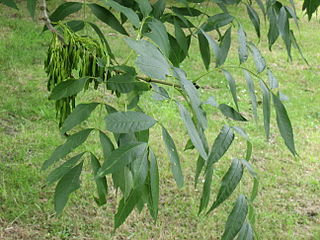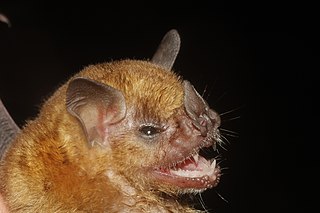
Fraxinus, English name ash, is a genus of flowering plants in the olive and lilac family, Oleaceae. It contains 45–65 species of usually medium to large trees, mostly deciduous, though a number of subtropical species are evergreen. The genus is widespread across much of Europe, Asia, and North America.

Fraxinus americana, the white ash or American ash, is a species of ash tree native to eastern and central North America. It is found in mesophytic hardwood forests from Nova Scotia west to Minnesota, south to northern Florida, and southwest to eastern Texas. Isolated populations have also been found in western Texas, Wyoming, and Colorado, and the species is reportedly naturalized in Hawaii.

Fraxinus excelsior, known as the ash, or European ash or common ash to distinguish it from other types of ash, is a flowering plant species in the olive family Oleaceae. It is native throughout mainland Europe east to the Caucasus and Alborz mountains, and the British Isles which determine its western boundary. The northernmost location is in the Trondheimsfjord region of Norway. The species is widely cultivated and reportedly naturalised in New Zealand and in scattered locales in the United States and Canada.

Fraxinus pennsylvanica, the green ash or red ash, is a species of ash native to eastern and central North America, from Nova Scotia west to southeastern Alberta and eastern Colorado, south to northern Florida, and southwest to Oklahoma and eastern Texas. It has spread and become naturalized in much of the western United States and also in Europe from Spain to Russia.

Fraxinus latifolia, the Oregon ash, is a member of the ash genus Fraxinus, native to western North America.

The yellow-headed amazon, also known as the yellow-headed parrot and double yellow-headed amazon, is an endangered amazon parrot of Mexico and northern Central America. Measuring 38–43 centimetres (15–17 in) in length, it is a stocky short-tailed green parrot with a yellow head. It prefers to live in mangrove forests or forests near rivers or other bodies of water. It is sometimes considered a subspecies of the yellow-crowned amazon. It is a popular pet and an excellent talker. Poaching for the international pet trade has driven the species to near-extinction in the wild; around half of all wild-caught birds are thought to die in the process. The yellow-headed amazon is CITES I listed, and there are legal restrictions on its trade and ownership, including a certification system.

Fraxinus nigra, the black ash, is a species of ash native to much of eastern Canada and the northeastern United States, from western Newfoundland west to southeastern Manitoba, and south to Illinois and northern Virginia. Formerly abundant, as of 2014 the species is threatened with near total extirpation throughout its range, as a result of infestation by a parasitic insect known as the emerald ash borer.

Fraxinus angustifolia, the narrow-leafed ash, is a species of Fraxinus native to central and southern Europe, northwest Africa, and southwest Asia.

Fraxinus ornus, the manna ash or South European flowering ash, is a species of Fraxinus native to southern Europe and southwestern Asia, from Spain and Italy north to Austria and the Czech Republic, and east through the Balkans, Turkey, and western Syria to Lebanon and Armenia.

Fraxinus profunda, the pumpkin ash, is a species of Fraxinus (ash) native to eastern North America, primarily in the United States, with a scattered distribution on the Atlantic coastal plain and interior lowland river valleys from southern Maryland northwest to Indiana, southeast to northern Florida, and southwest to southeastern Missouri to Louisiana, and also locally in the extreme south of Canada in Essex County, Ontario. The pumpkin ash tree is native to swampland areas. It is a tree that is very important environmentally and economically. Currently, Fraxinus profunda is threatened by the emerald ash borer which is threatening all species of ash trees in North America. The fruits of the pumpkin ash tree are also the largest of all ash trees in eastern North America.

Fraxinus velutina, the velvet ash, Arizona ash or Modesto ash, is a species of Fraxinus native to southwestern North America, in the United States from southern California east to Texas, and in Mexico from northern Baja California east to Coahuila and Nuevo León.

The Honduran small-eared shrew is a species of mammal in the family Soricidae. It is found in Honduras and possibly in El Salvador, Guatemala, and Nicaragua.
Alfaroa hondurensis is a species of plant in the Juglandaceae family. It is endemic to Honduras.
Allenanthus hondurensis is a species of plant in the family Rubiaceae. It is found in Honduras and Mexico.
Tontelea hondurensis is a species of plant in the family Celastraceae found in Guatemala, Honduras, and Panama.

Fraxinus lanuginosa is a species of ash native to Japan and to the Primorye region of eastern Russia.
Caloptilia fraxinella is a moth of the family Gracillariidae. It is known from Canada and the United States.
Ceratozamia hondurensis is a species of cycad in the family Zamiaceae.

Sturnira honurensis is a species of bat found in Central America. Previously, it was considered a subspecies of the highland yellow-shouldered bat, but it has been considered distinct since 2010.

Fraxinus uhdei, commonly known as tropical ash or Shamel ash, is a species of tree native to Mexico and Central America. It is commonly planted as a street tree in Mexico and the southwestern United States. It has also been planted and spread from cultivation in Hawaii, where it is now considered an invasive species.















